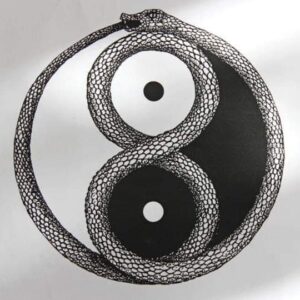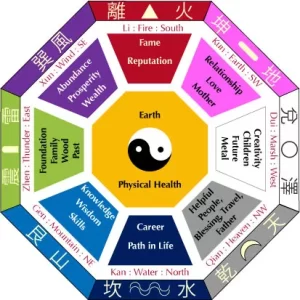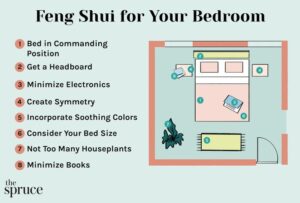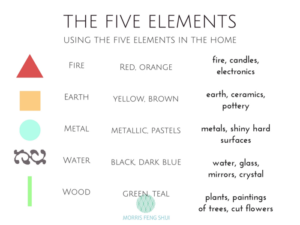Feng Shui, an ancient Chinese art, dates back over 3,000 years. It focuses on harmonizing individuals with their surrounding environment. The practice of Feng Shui involves arranging your living space to balance the natural world’s energies. This balance purportedly enhances wealth, health, and happiness. Whether you’re new to this philosophy or looking to refine your home’s energy, applying Feng Shui tips can transform your living space profoundly.
Understanding Feng Shui: The Core Principles
Feng Shui operates on five core principles: the Command Position, the Bagua, the Five Elements, Yin and Yang, and Qi. These principles help create a flow of positive energy and prevent the accumulation of negative forces within a space.
1)The Bagua
Bagua is an energy map applied to your living space to identify different areas affecting your life. The simplest method to apply the bagua in your life and to enhance your home with Feng Shui is to pinpoint one to three sections that require the most improvement. Avoid trying to address all areas simultaneously. To boost your energy or enhance circulation in those specific areas, utilize Feng Shui techniques tailored to each one.

2)The Five Elements
3)Yin Yang
Yin and Yang represent the balance of opposites, ensuring there is neither too much passivity nor activity.

The goal in Feng Shui is to balance Yin and Yang within your environment, creating spaces that are neither too overstimulating nor too subdued. An imbalance might manifest as a room that feels either too chaotic and loud (excess Yang) or too cold and deserted (excess Yin). Here’s how to achieve this balance:
- Interplay of Light and Shadow: Ensure that spaces have a good balance of light and dark. Use soft lighting to bring warmth to overly bright areas, or introduce elements of natural light to brighten up darker spaces.
- Furniture and Layout: Mixing soft, plush furniture with more angular, rigid pieces can balance the softness of Yin with the hardness of Yang. The arrangement should allow for easy movement (Yang) but also include cozy, enclosed spaces for rest (Yin).
- Color Schemes: Use a mix of colors that reflect both Yin and Yang. Cooler, softer colors (blues, greens, and purples) can calm a space, while warmer, brighter colors (reds, oranges, and yellows) can energize it.
- Material and Texture: Incorporating a variety of materials and textures can help balance a space. Combine rough textures (Yang) with smooth, silky ones (Yin) to create a tactile balance that mirrors the conceptual balance of Yin and Yang.
4)Qi
Qi (also spelled “chi”) is a fundamental concept in Chinese philosophy and medicine, representing the vital life force that flows through all living things. It is often described as the energy that animates the universe and every organism within it. In the context of Feng Shui, Qi refers to the natural energy of an environment, influencing the health, prosperity, and general well-being of the people living in that space.

A well-balanced environment facilitates a gentle and nurturing flow of Qi, which is believed to enhance the quality of life. Conversely, poor Feng Shui can lead to stagnant or hostile Qi, resulting in discomfort and obstacles in various aspects of life.
For managing Qi in your environment all you have to do is little changes like;
- Clearing Clutter: Clutter can trap and stagnate Qi, so keeping spaces clean and orderly helps maintain a smooth flow.
- Proper Arrangement: Furniture and architectural elements should be arranged to encourage a natural flow of Qi, avoiding sharp corners or barriers that might obstruct its movement.
- Natural Elements: Incorporating elements such as water, plants, and natural light can help enhance Qi. These elements are thought to attract and circulate positive Qi.
- Color and Decor: Colors and decorative choices also influence the movement and quality of Qi. Different colors can energize or calm a space, thus affecting the flow and feel of Qi.
5)The Command Position
In Feng Shui, the Command Position is a fundamental principle that governs the placement of important furniture within a room, particularly the bed, desk, and stove. This position is not just about furniture placement but about orienting oneself in a way to maximize personal control and security in your environment.
The Command Position is about visibility and protection. By placing key pieces of furniture where you can see the entrance, you symbolize readiness and openness to life opportunities and threats. This stance helps reduce anxiety and increases your command over your life circumstances.
Here are some tips for your home to achieve core principles of Feng Shui:
Enhancing Your Bedroom with Feng Shui Bed Placement

Your bedroom is crucial for relaxation and rejuvenation. Proper feng shui bed placement ensures you receive restful sleep and wake up refreshed. Ensure your bed is in the Command Position, which means placing it where you can see the door but are not directly in line with it. Avoid placing your bed under a window or directly opposite the door. Keeping a clean space under your bed also promotes better energy circulation.
Optimizing the Front Door with Feng Shui Cures
Feng Shui how to optimize your entrance involves ensuring your front door is visible and accessible, promoting good energy flow into your home. Paint your door in a color that contrasts with the surrounding walls to attract positive energy. Adding a mat and bright lighting can invite prosperity and happiness.
Attracting Wealth with Strategic Decorations
Identify your home’s money corner using the Bagua map—typically the southeast corner—and enhance it with specific feng shui cures. Adding elements like water features can boost prosperity. Also, place vibrant plants like the Jade Plant in this area to attract wealth. Ensure that this corner is clutter-free and well-lit to maintain the flow of wealth energy.

Selecting Feng Shui Plants for Good Energy
Plants for good luck such as Bamboo, Jade Plants, and Money Trees are not only aesthetically pleasing but also bring a vibrant chi into your home. Place these feng shui plants in corners where energy feels stagnant. They help in purifying the air and enhancing the vibrancy of any space.
Bringing It All Together for Harmony and Balance
Adopting feng shui decorating strategies allows you to create a balanced, harmonious home. Remember, the key to effective Feng Shui is maintaining cleanliness, minimizing clutter, and ensuring your decor complements the natural balance of elements. Whether you’re arranging your office space or optimizing your home for health and wealth, these feng shui tips provide a foundation for creating a serene and prosperous living environment.
Start applying these principles today to transform your home into a sanctuary of balance and positivity.

